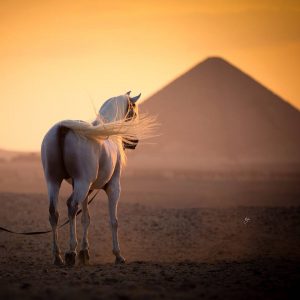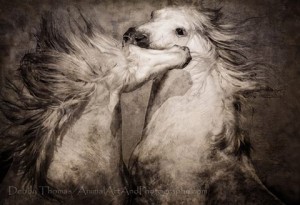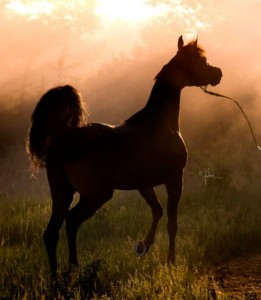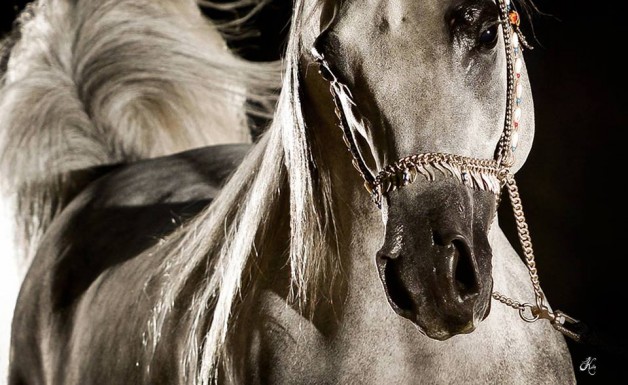by Keri Wright
BACKGROUND
The history of even the world’s greatest nations and civilizations, indeed, of all things conceived, founded, framed, and built by mankind is most often measured in days, months, years, decades, and perhaps even in centuries. But when it comes to the Arabian horse, we must adjust the metric and think in terms of millennia. Such ancient origins have veiled its exact beginnings from the prying gaze of a passively curious world. The Arabian can only truly be known through a magical and yet natural combination of historical fact, legend, and the Divine as they touch and awaken a part of our souls and bid us to know them, love them, and, in an increasingly hostile environment, protect them. Their world, like ours, is changing, and much of what has been and should be is sadly at risk of being lost altogether.
Down through the ages of time the Bedouin faithfully served as companion and friend of the Arabian horse. Modernization, as well as other forces not of their own choice or making, have drastically, and in some cases, forever altered the long-standing interdependence between man and horse. Who among us, as fellow sojourners here upon the earth, can ever pretend to fully know the heart of another? Thus it is that while we cannot fully comprehend all of their motivations, yet we can be, and must be, forever grateful that key people, under circumstances that can now be viewed as nothing short of miraculous, stepped forward and assembled and preserved the very best and finest Arabian horses of their day. While this was initially done through the efforts of individuals like Abbas Pasha I, Ali Pasha Sherif, and Lady Anne Blunt, yet among the nations of the earth one, in particular, became the special guardian of these creatures born of the desert wind and endowed with the seeming ability “to fly without wings.” Such was Egypt, and to her we all owe a tremendous debt of gratitude. Hearing of the fabled beauty of the Egyptian Arabian horse, many flocked to her doors, hopeful, even anxious, of being able to acquire horses that would form the foundation for or important additions to their own breeding programs. Several public and private studs from all over the world — Poland, Russia, Germany, Hungary, Spain, England, and the United States — were beneficiaries of Egypt’s generosity and at times her necessity.
Challenges and uncertainties in the Middle East being what they were, like-minded people, inspired by the lives of these early breeders and collectors of living art, came together and formed what is known today as The Pyramid Society whose mission it is to preserve, perpetuate and promote the Straight Egyptian Arabian horse as the premier source of classic Arabian type in the world. As the leader of an international community of breeders and owners, The Pyramid Society strives to unite its members in the breeding of superior quality Straight Egyptian horses, and to encourage the use of their blood as a source of the classic refinement necessary for the Arabian breed at large.
In a recent press release dated November 1, 2012, The Pyramid Society announced the release of its Standard of Excellence: A Guide to The Pyramid Society Straight Egyptian Arabian Horse, the essential new publication presenting the ideal framework for seeing, evaluating, judging, and showing the Straight Egyptian Arabian horse. Having made its debut as the centerpiece of the highly esteemed Fifth National Egyptian Breeders Conference, held in October 2012, the Standard of Excellence will now become the basis for judging at the Society’s annual Egyptian Event, beginning in 2013.
Meticulously designed by The Pyramid Society’s Education Committee for use in the field, the new Standard of Excellence booklet covers a full range of breed characteristics, including Type, Head, Neck & Shoulder, Body & Topline, Legs & Hooves, Movement, Endurance & Stamina, Tail Carriage, Color, Markings & Coat, Skeleton & Height, and Character all in addition to a new category to be implemented at the 2013 Egyptian Event: Balance, Quality & Substance at the Walk! The Standard’s 36 full-sized pages combine a treasure trove of historical quotes with clear, concise teachings and specific illustrations, making it a must-own resource for beginners and experts alike.
Since its inception, The Pyramid Society has worked tirelessly to establish a clear definition of the Straight Egyptian Arabian horse, promoting breeding excellence through a variety of member programs, educational activities, and premium publications. The public release of this Standard of Excellence, which itself draws earnestly from a vast collection of modern and historical studies of the Arabian breed, represents a critical moment in the life of The Pyramid Society, reaffirming the organization’s role as the torchbearer for Egyptian Arabian breeders, owners, trainers, and handlers worldwide.
WHY? AND WHY NOW?
With its release, two important questions come to mind: Why? And, perhaps of equal importance, why now?
WHY?
“Without clear standards, all breeding and judging of exhibition livestock would come down to a simple matter of opinion.”1
“In essence a breed standard is a blueprint for an animal fit for the function it was bred to do – i.e., herding, tracking, etc.”2
“Standards provide the fundamental basis of all forms of livestock competition in which the appearance of the animal, as opposed to its ability to perform tests, jump obstacles or run more quickly than its peers, determines success or failure. Standards state what breeders and exhibitors should look for in the perfect specimen.”3
“Breed standards are devised by breed associations or breed clubs, not by individuals, and are written to reflect the use or purpose of the species and breed of the animal. Breed standards help define the ideal animal of a breed and provide goals for breeders in improving stock.”4
The purpose of the breed standard is to serve as a guide, a general framework, within which breeders make their own decisions as to style, details and, in this instance, use of the horses they will breed. The standard provides a general repository of answers to potential questions about essential elements of type and structure.
“Breed standards are an invaluable herd improvement tool in that they should be studied by all breeders when they are determining their breeding objectives. They are used in selection and/or retention of sires/dams in the breeding program. The use of a breed standard is valuable in terms of bringing about genetic improvement within a single herd and across the whole industry.”5
Finally, a breed standard serves to unite breeders and to make the collective eye single to the recognition of ideal Arabian type. Lady Wentworth put it this way:
“Many men worry more about measurements than type, and are lost without their inch tape and their measuring standard … An ‘eye’ for a horse is a gift like an ear for music. It is a sense of proportion and harmony and corelation, the power to balance the points at a glance.”6
WHY NOW?
While trying not to “reinvent the wheel” the Standard of Excellence seeks to build upon the experience of previous generations of breeders and unify current breeders. We do so by analyzing the historical writings, photos and artwork pertaining to the origins and original use of the Straight Egyptian Arabian horse. In other words, the classic Arabian type for which the Straight Egyptian is so well known is the perfect relationship between their original form and original function. As noted by world-renowned Egyptian Arabian breeder, Judith Forbis:
“The Arab of the desert did not consult books in creating the classic Arabian horse — the universe and the principles of nature were his library. Harmony was his guide. The rapport established between the Arab and his horse evolved through shared interests, shared loyalties, shared consideration — and shared results. All the real (intangible) qualities we admire in the Arabian horse today are a result of a long heritage established through companionship and mutual respect.”
VARIANCES IN STYLE
Within the standards of type there also exist acceptable variances, known as style. For example, a group of individual horses may all exhibit the five hallmarks of type (head, arched neck, short back, comparatively level croup and high, natural tail carriage) and at the same time display different styles within the Straight Egyptian Arabian horse, like the difference we sometimes associate with individuals from varying families or strains (the more rounded lines of the Koheilan vs. the longer lines of the Saklawi). Variances in style are encouraged while variances in type are strongly discouraged and tend to detract from what it means to be Arabian. Regardless of chosen discipline, and whatever else they may be, they must first and always be good horses, good Arabians, and good representatives of the Pyramid Society Straight Egyptian. Although not always the case, style is frequently dictated by the family or strain. Some Master Breeders lock in a “style” which becomes their “look.” But ALL should meet the established parameters for TYPE within the standard. It must be noted that ALL styles that fall within the parameters for Egyptian Arabian type are acceptable! Straight Egyptians represent a much more limited and restricted portion of the already closed gene pool of the Arabian breed, in general. We, therefore, reject out of hand the notion that certain styles or bloodlines are somehow inferior to others. ALL bloodlines defined and recognized by The Pyramid Society as being Straight Egyptian are acceptable. We all have our favorite “look” and frequently go to great lengths to develop and to preserve or “lock in” that look. Such individual preferences in style and pedigree become a natural part of the selection process in both the horses we buy and the breeding decisions we make. Within every bloodline there are superior, average, and inferior horses and we never know when the very trait we may need in order to improve our own herds just might be found in a neighbor’s style of horse or from bloodlines that vary from our own.
A WORD OF CAUTION
One must also be cautious about trying to breed solely with showring fads or fancies as a guide. Such fads may unwittingly contribute toward eroding the foundations and unraveling the fabric of classic Arabian type. It is no wonder that astute breeders the world over constantly and consistently return to the blood of Straight Egyptians for the infusion of type so critical to the breed at large.

Worse yet are those owners, trainers and show committees who practice, encourage or tolerate inhumane and abusive training methods that take a horse who is naturally gentle and affectionate and turn it into a frightened, scared, and in some cases aggressive animal who exists on a level that can hardly be considered anything close to the kind of life enjoyed by its desert ancestors who were integral parts of the Bedouin family and were often found in the tents of their masters … a horse that likes to please and resents abuse. For this reason the Standard of Excellence also focuses on disposition and character of the horse.
“Attitude and physical qualities must be taken into account when considering the ideal Arabian; in fact, they must come first: love, courage, dignity, gentility, honesty, spirit, loyalty, grace, intelligence, and willingness to please. Without these transcendent values, the physical form cannot function and inspire.”7
ACKNOWLEDGMENTS:
1 British Cavy Council: http://www.britishcavycouncil.org.uk/Standards/
2 Wikipedia: http://en.wikipedia.org/wiki/Breed_standard
3 British Cavy Council: http://www.britishcavycouncil.org.uk/Standards/
4 Wikipedia: http://en.wikipedia.org/wiki/Breed_standard
5 Comparative Analysis of Alpaca Breed Type and Standards: http://www.alpacas.com/%5Calpacalibrary%5Ccomparanalyssbreedstandard.aspx
6 Lady Wentworth, The Authentic Arabian Horse, New York, NY: Sporting Book Center, 1979, 3rd ed. & The World’s Best Horse, London: Allen and Unwin. 1958
7 Judith Forbis:, The Classic Arabian Horse, New York, NY: Liveright, 1976 National Breeder’s Conference, Creating Standards in Egyptian Arabian Breeding: The Making of Standards: A Model from The Pyramid Society by Lisa Lacy and Becky Rogers
Illustrations and Drawings used by permission of Peter Upton
Alfred de Dreux Print: Omar, 19th century print, courtesy Judith Forbis
A CHANGING WORLD
As noted earlier, the world of the Arabian horse is changing. As guardians and stewards we have a responsibility to see that the classic Arabian horse, fashioned and preserved as it has been in its ideal form, will continue on by adhering to the principles and practices that are most closely aligned with those of its origins — fact, legend, and Divine appointment. As members of The Pyramid Society we feel confident that as you acquire, then read and study the new Standard of Excellence, you, like so many others around the world, will be drawn toward the classic type for which Straight Egyptian Arabians are so well known. We invite your further interest and inquiries and sincerely hope you will join in our shared vision and quest.
The Pyramid Society’s Standard of Excellence is now available to the public exclusively through The Pyramid Society’s online Marketplace at PyramidSociety.org or by calling The Pyramid Society’s offices at 859-231-0771.



